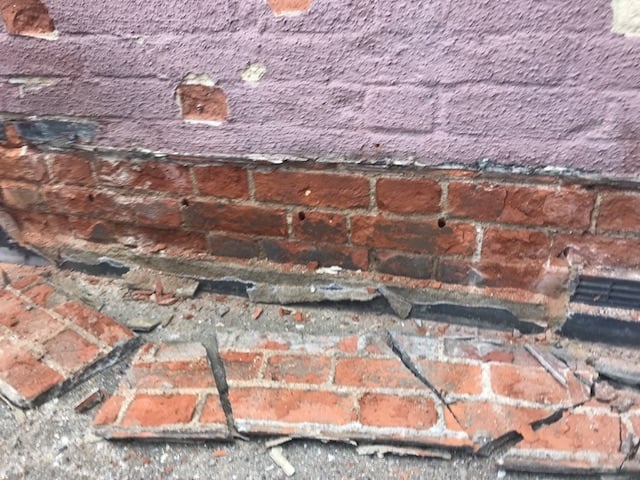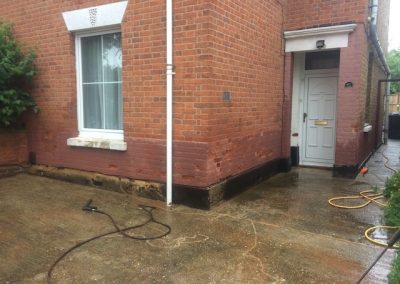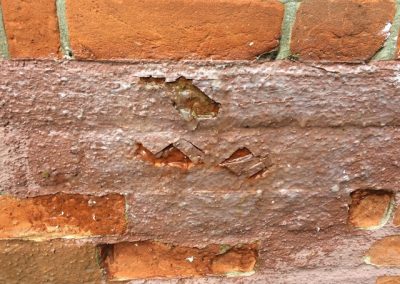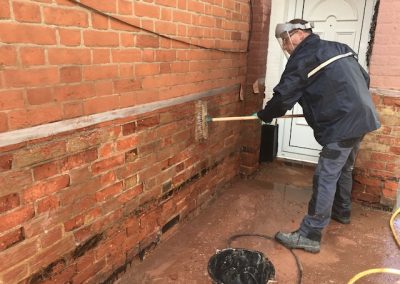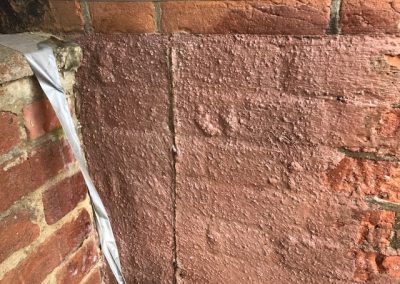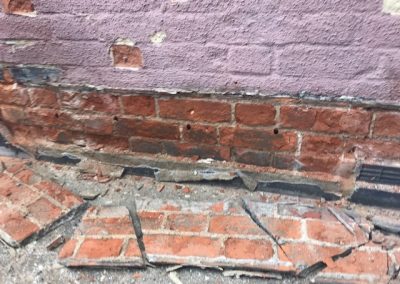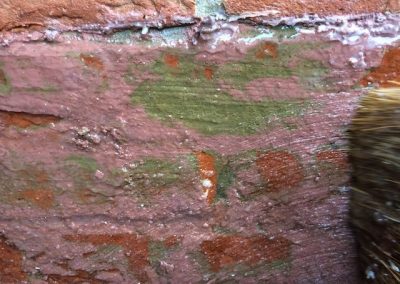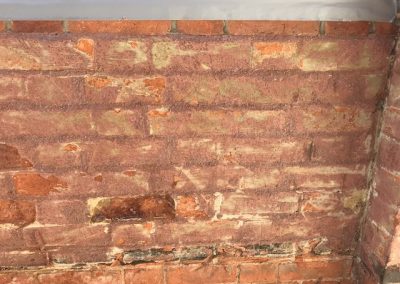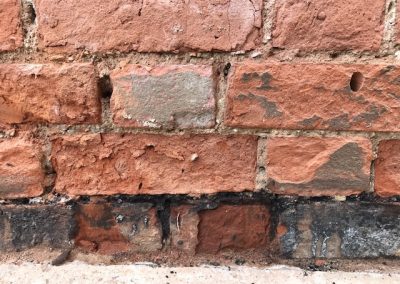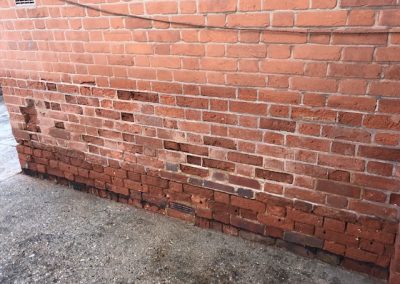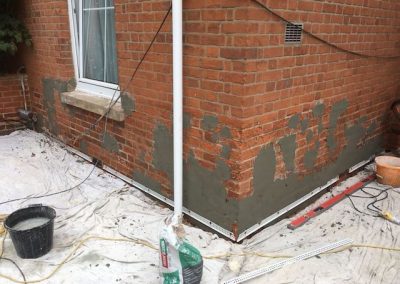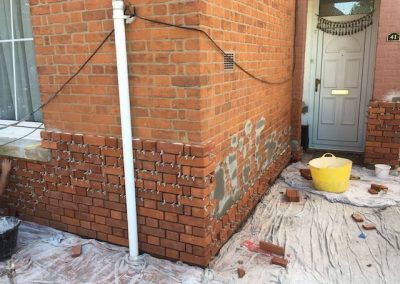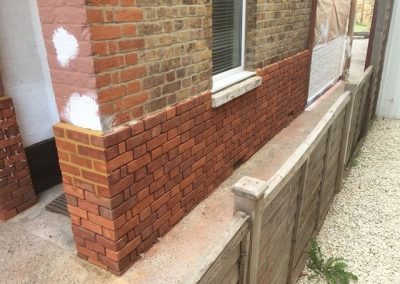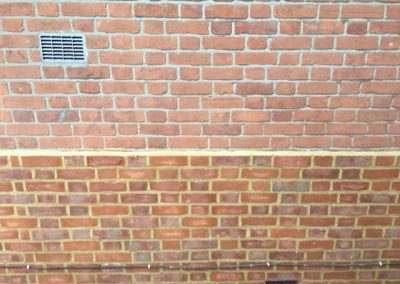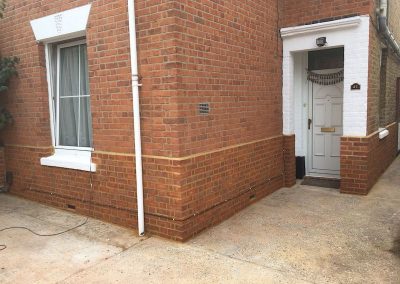A Brick Cladding Solution to damaging Textured Coating
Here we remove textured spray paint from the soft brickwork of this late Victorian house in the Maidenhead area.
Once we removed the wall spray coating the only solution to cure the damp and spalling brickwork erosion was to re-face the lower walls with sliced down handmade bricks (or brick cladding slips) to provide the aesthetic solution.
Background to the project: The lower brickwork on the front facade is a very soft handmade brick. Over the years the walls which are solid build, that is constructed of two skins of bricks tied together with brick stretchers, (with no cavity).
Many years ago the bricks started to erode due to freeze-thaw cycles. This brick erosion is also known as spalling. Cement pointing had also exacerbated the freeze-thaw damage to the bricks by squeezing the rain and moisture into the bricks, instead of the actual mortar absorbing the damp and being somewhat sacrificial the bricks themselves became the material that suffered years of damage through the relentless, punishing British weather
If caught early enough the spalled bricks could have been removed and turned around and put back in the wall, or the odd one replaced, but the brickwork was already badly spalled prompting the owners to seek a cure.
In order to reduce the slight rising damp problem as it was then, a chemical injection was installed. A damp proof injection course usually involves drilling holes at an angle into the bricks or stone and injecting a course of the masonry with silicone type chemicals (more often creams nowadays) this is to try and form an impervious horizontal barrier to stop rising damp. As is often the case with many old buildings, this chemical injection remedy did not work.
When this damp course injection failed to cure the damp a local builder was called in who then recommended that the lower walls to the front be rendered (tanked) in a concrete render, and painted with bitumen.
This hard render not only stopped the lower brickwork from breathing it bridged the original damp course. This created significant additional damp problems. The brickwork continued to erode and the damp became worse
After all this unnecessary work, around twenty years ago the owners of this fine period home, had a sales presentation for a spray applied wall coating performed for them in their home. It was said that this wall coating would cure the problems of the damp bricks and the spalling brickwork. The sales pitch which also included a promotional video promised the coating would be microporous thus allowing the walls to breathe. The homeowners informed us it was all very impressive and they paid many thousands for the brick red coloured textured coating to be sprayed onto the brickwork. Almost as if the old damp brickwork had an allergic reaction to the textured paint after a couple of years, the coating started to bubble and blister in places. To make matters worse before the spray coating had been applied the bricks were brushed with a strong sand and cement slurry mix which contained PVA glue, this again sealed damp in the bricks. The owners also hated the looks of the porridge-like spray exterior wall coating.
Enter the age of the internet and after some googling, the owners contacted TCR to arrange a survey with a view to getting the textured paint cleaned off, curing the damp problems and restoring the lovely brickwork & masonry.
During the test patch in which we applied strong paint strippers and hot water pressure jetting, we actually removed some of the exterior spray wall coating and the cement slurry lurking underneath.
Unfortunately, due to the soft brick, the thick textured paint which in itself is very hard to remove, the cement slurry layer behind the textured paint and the concrete render at the bottom of the wall, preserving and leaving the original brickwork intact was not feasible.
Our advice was to remove the spray wall coating and the cement slurry even though the brickwork would suffer some slight damage from the textured paint removal. We also recommended that the tar-coated concrete render plinth at the bottom of the wall be removed.
Once the paint cleaning from the bricks had been completed the walls would be able to breathe again. To provide an attractive protective finish we specified a brick cladding system for the spalled brickwork.
The specification was to re-face the lower walls in a brick tile cut from a handmade brick. The bricks slips were cut from Ibstock A4303A Swanage Handmade Light Red Multi. The 22mm thick brick cladding was bonded using a lime-based adhesive. The bricks were then pointed in natural hydraulic lime 3.5 and sharp sand. In addition to providing an attractive solution to the unsightly textured coating and damaged bricks. The brick cladding will also provide a protective barrier to driving rain. The clay bricks used for the cladding, lime adhesive and the lime pointing will all allow moisture to escape from the wall
The brick bond pattern is known as a Flemish bond, this was done to replicate the original brick configuration as is often seen in solid wall construction. To run inline with the original damp proof membrane course we specified a PVC stop bead, this was sandwiched between one brick course to act as a finger break and prevent rising damp entering the upper brick cladding layer.
Please take a look at the before and after pictures of the brick paint cleaning process and the brick cladding below
Textured coating concrete render causing damp and brick erosion
Textured coating concrete render causing damp and brick erosion

